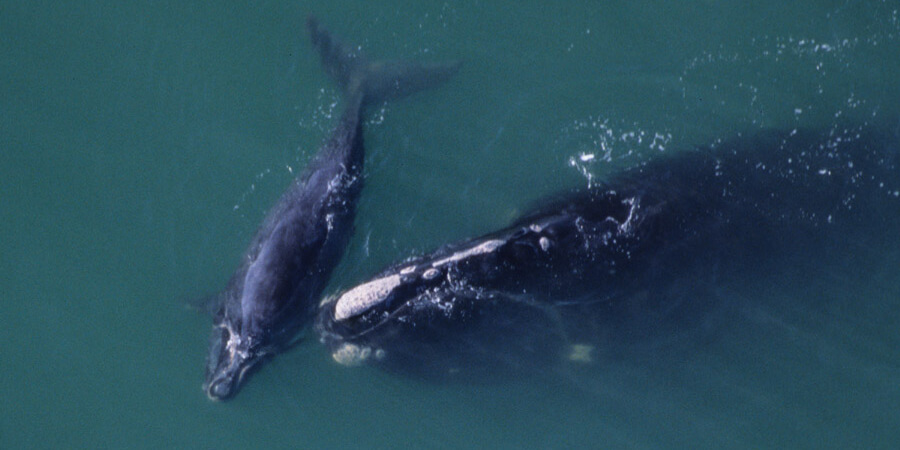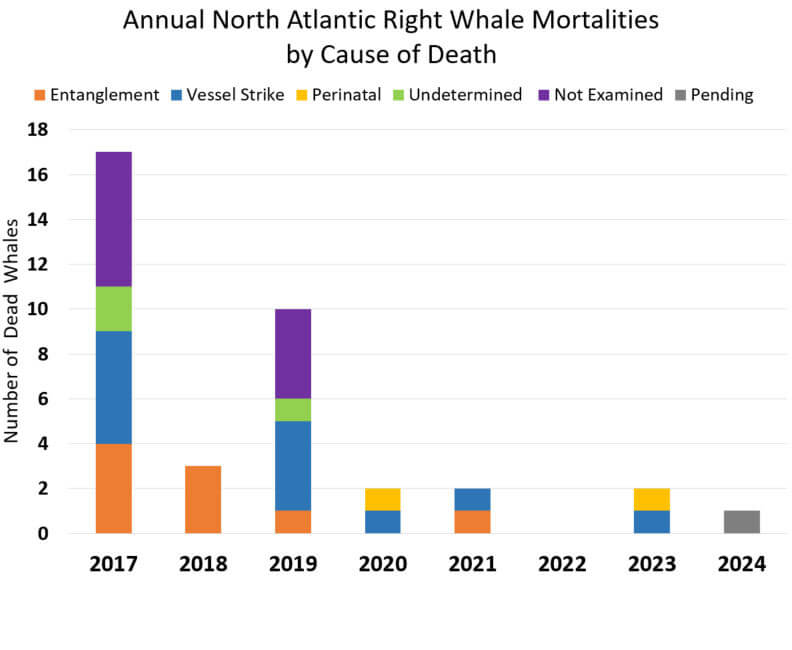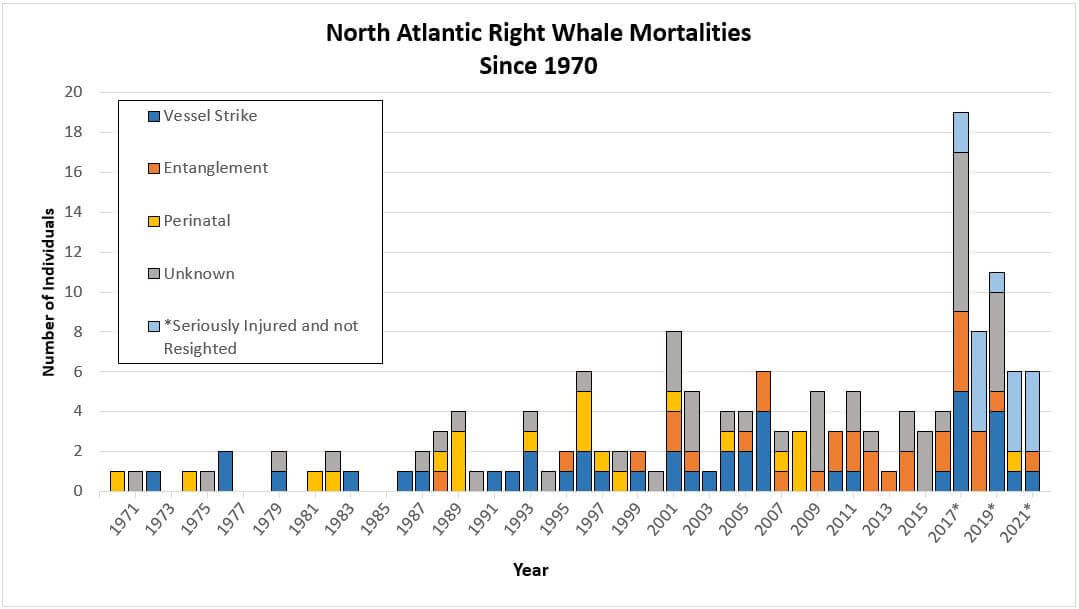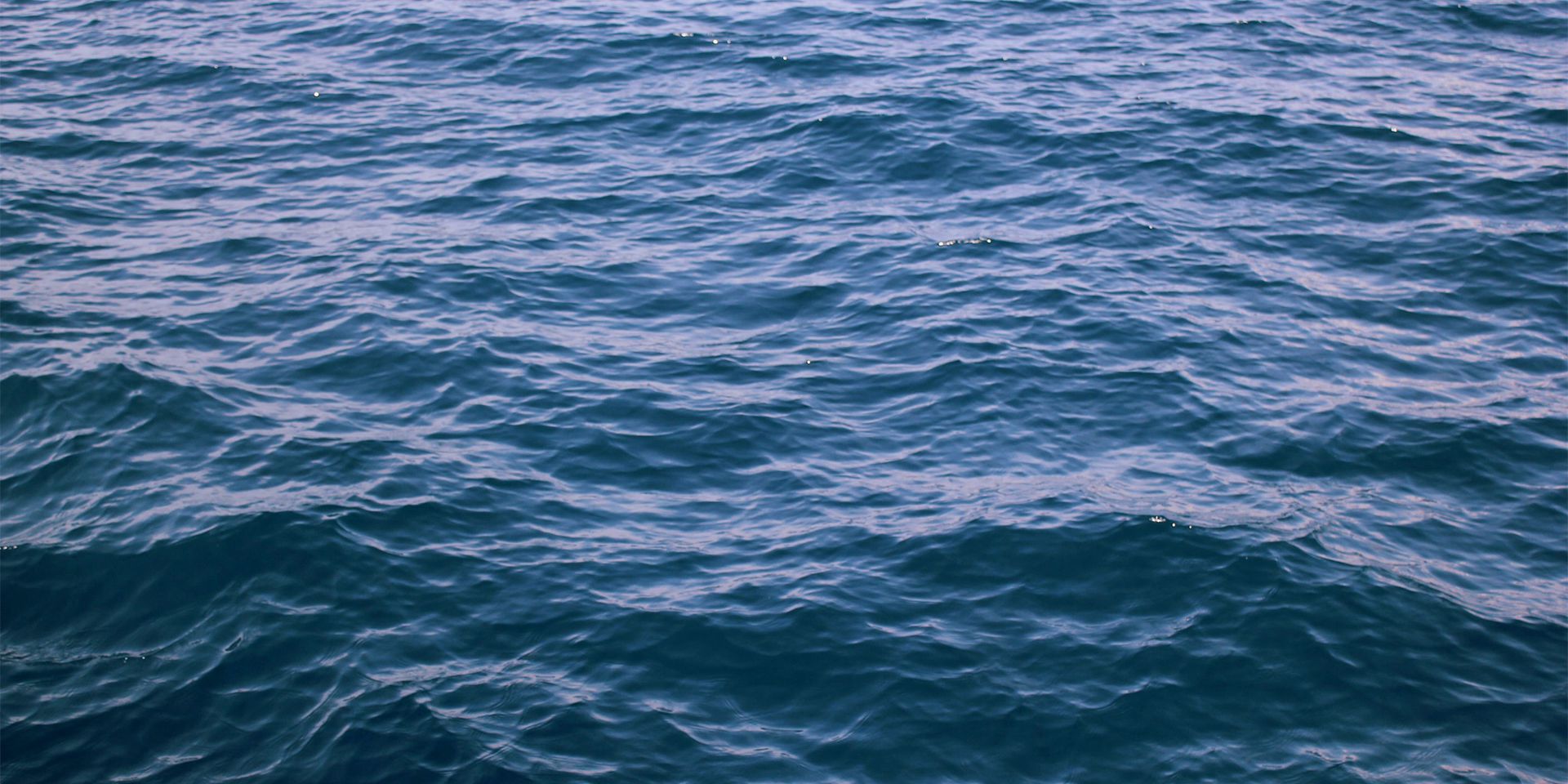North Atlantic Right Whale
The North Atlantic right whale (Eubalaena glacialis) is one the world’s most endangered species of large whale. North Atlantic right whales were first hunted as early as the 9th century by Norse whalers. Later, commercial whaling brought them to the brink of extinction by the early 1900s. The population off Europe had been virtually extirpated while a small population of perhaps a hundred or fewer survived in the western North Atlantic off the United States and Canada. After 1935, when an international agreement went into effect banning the hunting of all right whales, their numbers began to increase slowly. In recent decades, this slow recovery has been impeded by mortality and serious injury from vessel strikes and entanglement in fishing gear. North Atlantic right whales now occur almost exclusively along the east coasts of the United States and Canada, where they rely on a calanoid copepod, Calanus finmarchicus, as their primary food source.
The North Atlantic right whale is one of three right whale species, along with the North Pacific right whale and the southern right whale. Today, there are likely fewer than 500 right whales in the entire North Pacific, and approximately 30 individuals in the eastern North Pacific stock inhabiting U.S. waters, while southern right whale populations have seen steady increases since the end of commercial whaling in the southern hemisphere.

Right whales off Florida coast. (New England Aquarium)
Species Status
Abundance and Trends
During the 1990s, the North Atlantic right whale population fluctuated between periods of slow decline and periods of slow growth. In the first decade of the 2000s, it grew steadily but at a rate well below those of many other populations of large whales. In 2010, the population entered a period of decline that appears to be continuing due to high levels of human-caused mortality and declining calf production. Human-caused mortality and serious injury, particularly entanglements and vessel strikes, is the greatest threat to recovery of the species. Today, there are approximately 360 North Atlantic right whales in existence, with fewer than 70 reproductive-age females in the population. Female numbers are declining more rapidly than males, and the corresponding loss of reproductive potential leads to an alarming concern about an increasing risk of extinction.
On October 22, 2024, National Marine Fisheries Service (NMFS) announced that the North Atlantic right whale population estimate for 2023 was 372 (95% credible interval ranging from 360 to 383) individuals. This estimate is based on a new birth-integration approach (Linden 2024) that enhances a previously established capture-recapture framework (Pace et al. 2017, 2021) by incorporating known births into the population model. Using the prior population model, the 2022 population estimate was 356 (95% credible interval ranging from 346 to 363). The 2021 estimate was recalculated as 364 (95% credible interval ranging from 360 to 369). These recent annual population estimates suggest the sharp population decline observed between 2015-2020 may be slowing; however, the overall long-term population trend shows this species continues to face significant ongoing threats with annual mortality and serious injury estimates exceeding species recovery thresholds. These updated population estimates are considered preliminary and will be provided to the Atlantic Scientific Review Group for consideration in the 2025 Stock Assessment Review process. Twenty mother/calf pairs were observed in 2024, and as of 10 January 2025, five mother/calf pairs have been observed in the 2024/2025 calving season.
Distribution
Although North Atlantic right whales now occur almost exclusively along the east coasts of the United States and Canada, a few individuals have been observed entering the Gulf of Mexico and venturing across the Atlantic to European waters. Their current range is closely linked to their life history, contingent upon nursery areas and feeding grounds with the necessary habitat characteristics. Many North Atlantic right whales travel from their feeding grounds off the coast of the northeastern United States and Canada down to coastal waters of South Carolina, Georgia, and Florida in winter, while a portion of the population remains in more northern waters in areas such as south of Nantucket and around Cape Cod. The warm, shallow waters off the southeast U.S. coast serve as winter nursery grounds for the whales. The North Atlantic right whales then migrate north again along the east coast to their feeding areas, many arriving in Cape Cod Bay in early spring and then moving into productive waters of the Gulf of Maine and in more recent years, the Gulf of St. Lawrence. In recent years, the waters around Nantucket Shoals have been an important area with whales present nearly year-round. The North Atlantic right whale distribution seems to be shifting, yet questions remain about the permanency of the shift and the location of significant portions of the population at any given time.
Unusual Mortality Event: 2017 to Present

Annual North Atlantic Right Whale Mortalities by Cause of Death, 2017-2024 (NOAA)
Elevated mortality and serious injury levels since June 2017 led NMFS to declare an Unusual Mortality Event (UME) for North Atlantic right whales, which remains an open investigation. A total of 151 cases of mortality (n=41), serious injury (n=39), and morbidity (n=71) are included under this UME as of January 10th 2025, which represents more than 20 percent of the population. Vessel strikes and entanglements in rope were the predominant cause of death for those that could be examined; however, some of the whales that died could not be examined or were too decomposed to determine the cause of death. Most human-caused serious injuries (a determination that the injury is severe enough that the whale is likely to die from those injuries) and morbidity (sublethal injury or illness) cases involved entanglements, but include vessel strikes, as well as injuries or poor body condition of unknown cause.
While North Atlantic right whale deaths have been detected historically in U.S. waters, reflective of their distribution along the North Atlantic coast of the U.S., the majority of the carcasses reported in 2017 and 2019 were concentrated in Canadian waters. The increased presence of North Atlantic right whales in the Gulf of St. Lawrence in Canada is believed to reflect a northward shift in their prey, hypothesized to result from particularly strong climate-driven conditions, including ocean warming, in the waters of the northwestern Atlantic Ocean. This change in North Atlantic right whale distribution has led to an increase in bilateral communication and coordination between the United States and Canada on population management efforts and implementation of protective measures to reduce vessel strikes and entanglement in fishing gear.

Right whale mortalities from collisions with ships, entanglement in fishing gear, perinatal (new born calf) deaths, and unknown causes (NMFS). Note that individual whales that were seriously injured (by vessel strike or entangled in gear) and not resighted are included.
What the Commission Is Doing
Stakeholder Engagement and Managing Impacts of Fishing
To reduce threats due to fishery interactions to the North Atlantic right whale population and other large whales in the Atlantic, in 1996 we recommended that NMFS establish a take reduction team in 1996, which led to the establishment of the Atlantic Large Whale Take Reduction Team (ALWTRT) and the developed of a Take Reduction Plan (TRP) in 1997. A representative of the Commission has been a member of the team since its inception. More recently, the Commission expressed concern to NMFS regarding the 2017-19 spike in human-caused serious injuries and deaths of North Atlantic right whales, the population’s low birthing rate and declining population size, and the need for immediate, strong measures to mitigate human-based threats to the species. In March of 2021, the Commission submitted a letter to NMFS on the intent to prepare a draft environmental impact statement and to amend the current Atlantic Large Whale Take Reduction Plan iterating these concerns and offering specific recommendations for management actions.
In addition to engaging on the ALWTRT, the Commission has awarded research grants aimed at right whale conservation. For example, the Commission provided funding to evaluate the potential use of on-demand fishing systems in pot/trap fisheries in 2016, 2021, and 2022. A project focused on evaluating the efficacy of using broad-scale ship speed restrictions in the U.S. East Coast Exclusive Economic Zone for reducing large whale mortalities was funded in 2020. In 2021, the Commission awarded a grant that supports advancing whale conservation and outreach with sustainable infrastructure for WhaleMap. Funding was awarded to a project in 2023 examining baleen biochemistry to understand North Atlantic right whale health in the context of climate change.
A session at the Commission’s 2023 Annual Meeting focused on climate-driven shifts in distribution, prey, and threat and included a presentation and panel discussion on climate-driven shifts in right whale distribution, reproduction, and risk exposure. At its Annual Meeting on 5-7 April 2017 in North Falmouth, MA, the Commission devoted a session to receiving and reviewing recent information on the status of North Atlantic right whales. Among other things, it was noted that annual calf production in recent years has fallen to its lowest rate in 38 years and that the frequency and severity of entanglement-related wounds has been increasing significantly. Based on the information presented and discussed at the meeting, the Commission concluded that entanglement in fishing gear was the single greatest human-caused threat to North Atlantic right whales, and that measures to reduce the lethal and sub-lethal effects of entanglement in both the United States and Canada were inadequate.
Efforts to Reduce Impacts of Ship Strikes
The Marine Mammal Commission is continuing to monitor right whale deaths and injuries caused by ship strikes in U.S. waters, and making efforts to minimize their occurrence. Vessel speed zones that were established in 2008 by the National Marine Fisheries Service (NMFS) to reduce collisions with right whales by large vessels have been largely effective. In March 2014, the Commission recommended denial of a petition by the American Pilots Association requesting that dredged channels be exempted from speed restrictions in management areas. In 2014, we met with NMFS staff to review the status of the petition and also reviewed its status at our Annual Meeting in May 2015. NMFS denied the petition in October of 2015.
In June 2020, NMFS released a report that reviewed and synthesized many aspects of the effectiveness of the 2008 rule, including the increasing use of speed limits to protect whales in other parts of the country and world, volume of traffic and regulated vessel compliance with speed regulations, volume of non-regulated small-vessel traffic, effectiveness of the rule in reducing the number of serious injuries and deaths, vessel sizes involved in strikes of right whales, navigational safety, economic impacts, enforcement, and outreach. The Commission submitted a letter to NMFS on the North Atlantic right whale vessel speed rule assessment.
The Commission hosted a webinar on April 12, 2022 focused on “Federal Agency Approaches to Reducing Vessel Strike of Cetaceans”. The aim of this workshop was to review Federal vessel-routing and speed-reduction programs, their elements and effectiveness, identify locations where additional measures are or may be needed, and consider recommendations for next steps. These discussions included evaluations of the effectiveness of the Right Whale Vessel Speed Rule, incentive programs for industry environmental compliance and participation, as well as tools, such as Whale Map and the Whale Alert app, for communicating whale presence in areas where vessels and whales co-occur.
Commission Reports and Publications
Laist, David W., Knowlton, Amy R., and Pendleton, Daniel. 2014. Effectiveness of mandatory vessel speed limits for protecting North Atlantic right whales.
Laist, David W., Knowlton, Amy R., Mead, James G., Collet, Anne S., and Podesta, Michela. 2001. Collisions Between Ships and Whales.
Reports prepared for the Marine Mammal Commission:
Lowry, Lloyd, Laist, David W., and Taylor, Elizabeth. 2007. Collisions Between Ships and Whales.
Weber, Michael L. and Laist, David W. 2007. The Status of Protection Programs for Endangered, Threatened, and Depleted Marine Mammals in U.S. Waters.
Reeves, Randall R., Read, Andrew J., Lowry, Lloyd, Katona, Steven K., and Boness, Daryl J. 2007. Report of the North Atlantic Right Whale Program Review.
Commission Letters
| Letter Date | Letter Description |
|---|---|
| October 31, 2022 | |
| October 18, 2022 | |
| September 2, 2022 | |
| August 29, 2022 | |
| March 26, 2021 | Letter to NMFS on the North Atlantic right whale vessel speed rule assessment. |
| March 1, 2021 | |
| February 19, 2021 | |
| September 23, 2019 | |
| August 12, 2019 | |
| June 19, 2017 | |
| April 19, 2017 | |
| April 13, 2016 | Letter to U.S. Coast Guard on Atlantic Coast Port Access Route Study Final Report |
| April 21, 2015 | Letter to NMFS on proposed modification of critical habitat for North Atlantic right whales |
| April 20, 2015 | |
| November 21, 2014 | |
| March 4, 2014 | Letter to NMFS on a petition to exempt dredged channels from vessel speed restrictions |
| September 13, 2013 | |
| August 5, 2013 | Letter to NMFS on proposed rule to delete the expiration date for regulations limiting vessel speeds |
| April 20, 2012 |
Learn More
Threats
The primary causes of mortality and injury to right whales are entanglement in fishing gear and strikes by vessels. Another potential threat include spills of hazardous substances from ships or other sources. Lastly, noise from ships and industrial activities within their range is a great concern for the whales, and the Commission provides comments on proposed activities and recommendations on how to avoid or mitigate such threats.
Current Conservation Efforts
A recovery plan for the species was adopted in 1991 and updated in 2005. In 1994, three areas were designated as critical habitat. In January 2016 those areas were expanded and consolidated into two large areas, one covering waters off the northeastern United States in the Gulf of Maine from the U.S.-Canada border to eastern Massachusetts, and the other area along the southeast coast from southern North Carolina to central Florida (see NOAA National Marine Fisheries Service (NMFS) website for critical habitat maps). NOAA Fisheries appointed two recovery teams, the Northeast Implementation Team (NEIT) and the Southeast lamentation Team (SEIT), to assist with the development and implementation of the North Atlantic Right Whale recover plan. The NEIT and SEIT assists NOAA Fisheries Greater Atlantic Regional Fisheries Office and the Southeast Regional Office, respectively, on implementation of the recovery plan and issues related to the status and conservation of North Atlantic right whales.
NMFS and the Coast Guard have taken both regulatory and non-regulatory steps to reduce the threat of ship strikes, including mandatory vessel speed restrictions in Seasonal Management Areas, modification of international shipping lanes, enforcement, and public outreach.
To address entanglement in fishing gear, NMFS established the Atlantic Large Whale Take Reduction Team. This team has been unable to agree on all measures needed to meet take reduction goals and the NMFS has therefore developed a plan it believes will be necessary to reduce the incidental serious injury and mortality of right whales, as well as other whales. NMFS is in the process of considering additional mitigation measures in response to the impact of Northeast fisheries on North Atlantic right whales.
On February 3, 2022, NMFS announced its intent to conduct a 5-year review of the North Atlantic right whale. NMFS is required by the Endangered Species Act to conduct this 5-year status review to ensure listing classifications of the species is accurate based on the best scientific and commercial data available at the time of the review. Findings from the 5-year status review were published in November 2022, which concluded that no change to the listing status was warranted at that time.
Additional Resources
NMFS Marine Mammal Stock Assessment Reports by Species/Stock – Right Whale, North Atlantic
NMFS 2005 Recovery Plan for the North Atlantic Right Whale
North Atlantic Right Whale Recovery Plan Northeast U.S. Implementation Team
North Atlantic Right Whale Recovery Plan Southeast U.S. Implementation Team
NOAA Interactive Map of North Atlantic Right Whale Sightings
Canada – WhaleMap: Latest Right Whale Observations
NMFS – Reducing Vessel Strikes to North Atlantic Right Whales
NMFS – North Atlantic Right Whale
North Atlantic Right Whale Consortium
North Atlantic Right Whales: Evaluating Common Misconceptions
